Metropolitan Electric Tramways
Summary
Metropolitan Electric Tramways Limited was expressly formed to take over and electrify horse-operated tramways in north London, most notably, the North Metropolitan Tramways Company. Whilst the METL owned and operated horse-drawn tramway services for nearly three years (1902 to 1905), it actually left operational matters in the hands of the NMTCo, so the tramcar crews working these services essentially continued to wear whatever they had worn previously, i.e., under the independent NMTCo.
The METL, as well as its predecessor, the Metropolitan Electric Tramways and Omnibus Company Limited, was a subsidiary of the much larger British Electric Traction Company Limited (BETCo), a concern which at its zenith either owned, part-owned or leased almost 50 tramway concerns across the British Isles. Photographs taken in the first 15 years or so of electric operation clearly show BETCo tramway staff wearing the familiar and largely regulation BETCo uniform. Although jackets appeared to vary somewhat between BETCo systems, as well as across the decades, the cap badges, collar designations and buttons invariably followed a standard pattern.
Following the introduction of the MET electric services in 1904, tramcar crews were issued with double-breasted jackets with four pairs of buttons (with a fifth pair buttoning between the collars and lapels), and three pockets at waist level; the collars carried embroidered system initials on both sides ('M E T’). Caps were peaked with a tensioned crowns (top), and carried the standard brass BETCo ‘Magnet & Wheel’ cap badge (see below). However, unlike most other non-London BETCo tramway systems, an employee number was not worn on the cap, possibly due to the requirement for crews to wear a numbered, enamel Public Carriage Office licence (see link) when working. Although this style of double-breasted uniform jacket was relatively quickly superseded on the vast majority of BETCo systems, for some reason, the METL saw fit to retain it right through its independent existence and up until the end of the Great War.
Following the transfer of the MET into the London & Suburban Traction Company Limited in 1913 — a holding company jointly owned by the Underground Electric Railways Company of London Limited and the BETCo — no change appears to have been made to the uniform policy; however, after the end of the Great War, and possibly as late as 1922, uniforms were standardised across all three constituent tramways of the L&STCo: Metropolitan Electric Tramways, London United Tramways and South Metropolitan Electric Tramways. The double-breasted style of jacket with lapels continued to be used (navy blue serge with red piping), but with the embroidered 'M E T' initials on the lapels now being replaced by one-piece brass 'MET' system initial badges. These lapel badges exist both with and without a lozenge-shaped surround (see below), the significance of which is unknown. The standard BETCo 'Magnet & Wheel' cap badge was also replaced, a large nickel and blue enamel cap badge taking its place; this took the form of the Underground Group's 'bullseye', and bore the word 'TRAMWAYS' across the middle, with 'METROPOLITAN' in the circle above and 'ELECTRIC' below.
Similar cap and lapel badges also exist (see below) that are just marked 'TRAMWAYS'; these were more than likely issued to staff who worked across all three LSTCo tramway systems, such as ticket issuers/collectors etc. Bullseye cap badges also exist for specific grades — 'OFFICIAL' and 'MESSENGER' are known — with all three constituent tramways in the circle above (see below).
Staff were initialled expected to provide their own coats, though the company eventually issued them with heavy double-breasted greatcoats with five pairs of buttons and lapels; the collars appear to have carried 'M E T' initials, possibly embroidered, though they were probably superseded by metal badges at some point. In the early years, the greatcoats did not have epaulettes; although they later had epaulettes, they do not appear to have borne any insignia.
Prior to the tramways absorption into the LSTCo, inspectors wore uniforms that followed standard BETCo senior staff uniform practice, namely: single-breasted jackets with hidden buttons (or more likely an hook and eye affair) and stand-up collars, with the pockets and the jacket edged in a finer material than the main body. The collars carried the bearer's grade — 'Inspector' — in embroidered script lettering; the caps also bore a hat band bearing the grade — 'Inspector' — with the standard BETCo 'Magnet & Wheel' badge worn above. Although it is currently unclear what uniforms were worn during the LSTCo era, the cap badge was definitely changed to a 'bullseye' pattern with 'INSPECTOR' across the bar in the middle (see below). This badge was smaller in size than the standard badges issued to motormen and conductors; a similar badge was also issued for the grade of 'REGULATOR'. District Inspectors — a more senior LSTCo grade — were issued with a small circular, brass and blue enamel cap badge (see below).
Female staff were employed in significant numbers during the Great War (from late 1915 onwards) to replace male staff lost to the armed services; these ladies were issued with tailored, single-breasted jackets with five buttons, lapels and a waist belt (with button fastening), along with a medium-length matching skirt and lace-up gaiters; the lapels bore 'M E T' in prominent embroidered letters. Headgear took the form of a dark-coloured, wide-brimmed straw bonnet for summer use (probably) and a similar shaped grey felt hat for winter use; both styles of hat bore the standard BETCo 'Magnet & Wheel' cap badge (probably on a hat band).
A 1907 issue of the BETCo house magazine, 'BET Gazette', reveals that the M.E.T had a total of 36 inspectors and regulators (at that time) and 395 tramcar crew (information taken from 'North London Trams by R J Harley; Capitol Transport [2008]).
For a detailed history of the system, including its predecessor companies, see: 'Metropolitan Electric Tramways, Origins to 1920, Volume 1' and '1921 to 1933, Volume 2' by C S Smeeton; Light Rail Transit Association (1984 and 1986).
Images
Horse tram drivers and conductors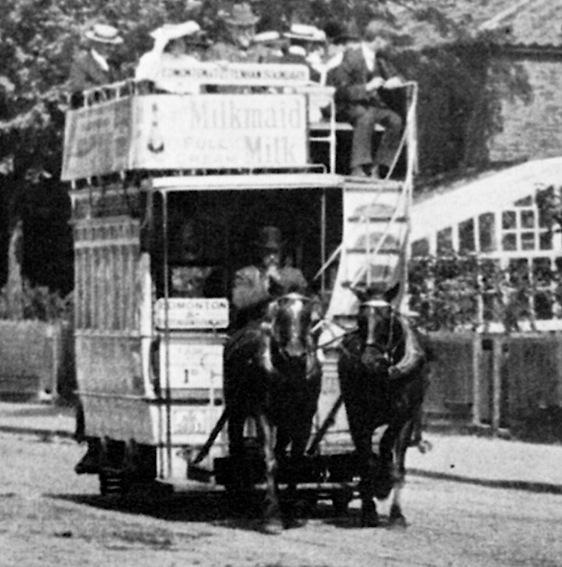
M.E.T horse tram shuttle working between Tramway Avenue in Edmonton and the Tottenham boundary — 1905. The driver is wearing informal but robust attire, a policy which the M.E.T did not see fit to change when it took over the erstwhile North Metropolitan Tramways Company. Photo courtesy of the Tramways and Light Railway Society, with thanks to David Voice.
Motormen and conductors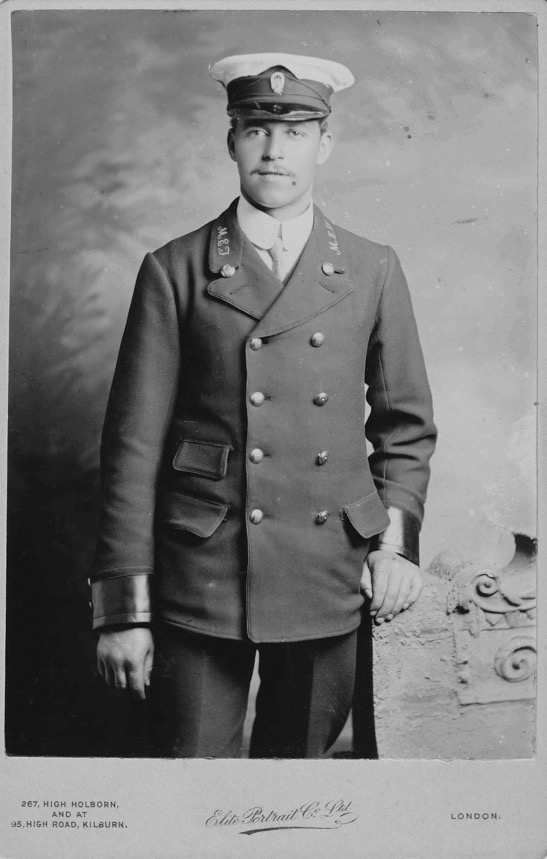
A superb portrait of an Metropolitan Electric Tramways tramwayman, very probably taken around the time that electric services were introduced, i.e., 1904. The photo was taken in the studios of the Elite Portrait Co Ltd. Author's Collection.
An enlargement of the above photograph showing details of the jacket and cap insignia. The jacket collars bear embroidered system initials, the cap a BETCo 'Magnet & Wheel' badge. Unlike the vast majority of BETCo systems, there is no employee number on either the jacket or the cap.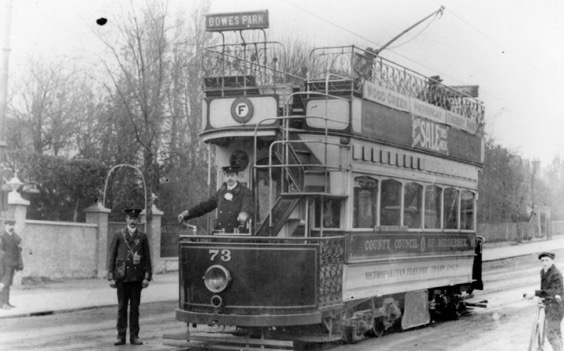
A conductor and motorman pose with Tramcar No 73 on a short working to Bowes Park — photo probably taken in 1906. Photo courtesy of the Tramways and Light Railway Society, with thanks to David Voice.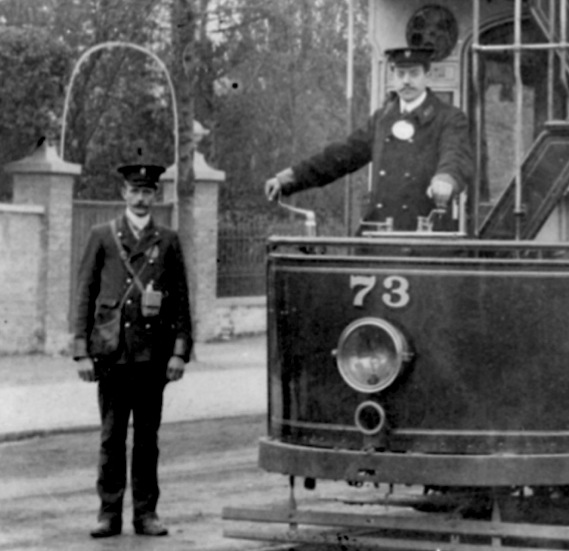
An enlargement of the above photograph showing the conductor and the motorman. The standard BETCo 'Magnet & Wheel' cap badge can just about be made out.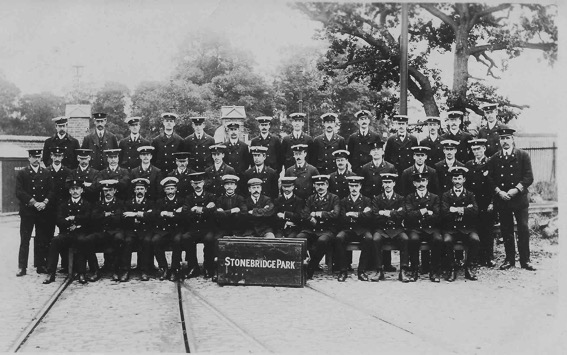
A staff photograph taken at the M.E.T. depot at Stonebridge Park — although undated, the prominently positioned depot name strongly suggests that it was taken to commemorate the opening of the depot at the end of 1906. Photo courtesy of the Dave Jones Collection. 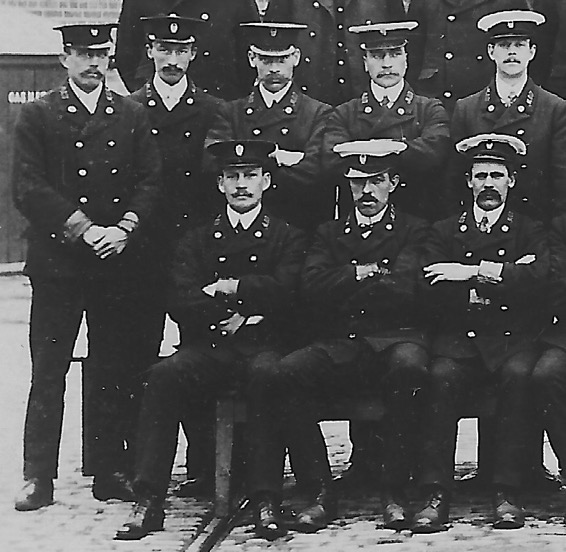
An enlargement of the above photograph showing some of the men. It is unclear whether their jacket collars bear embroidered or metal collar insignia. The tensioned-crown peaked caps bear just the BETCo 'Magnet & Wheel' device, without an employee number.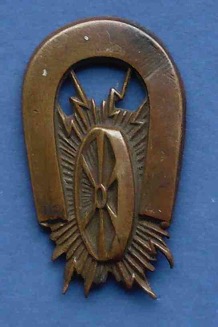
Standard British Electric Traction Company ‘Magnet & Wheel’ device cap badge — brass. These were worn from the inauguration of electric services (in 1904) through to the early 1920s. Author's Collection.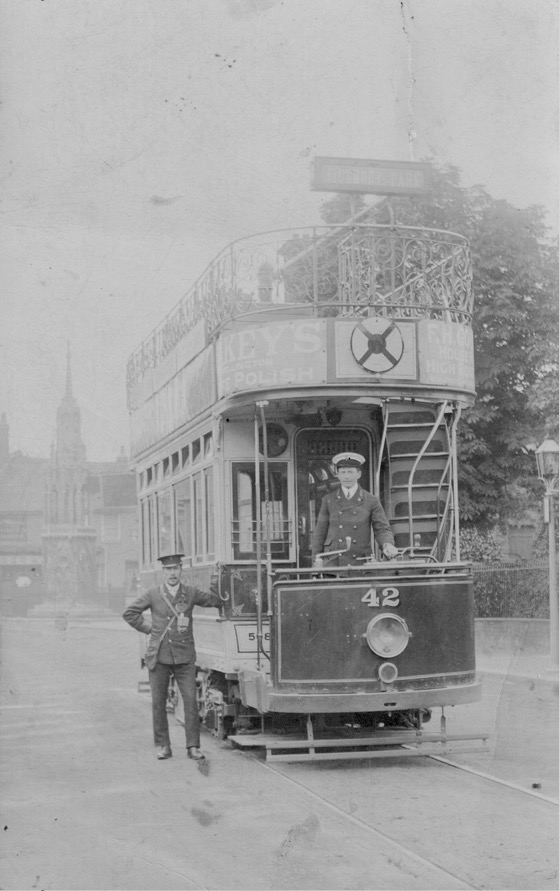
The crew of Tramcar No 42 pose for the camera at Waltham Cross — photo undated, but almost certainly taken the year the line reached there, i.e., in 1908. Author's Collection.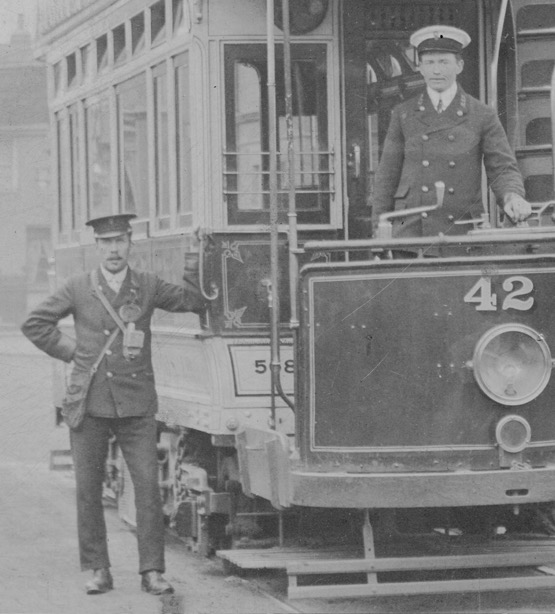
An enlargement of the above photograph showing the conductor and motorman (W Moore). 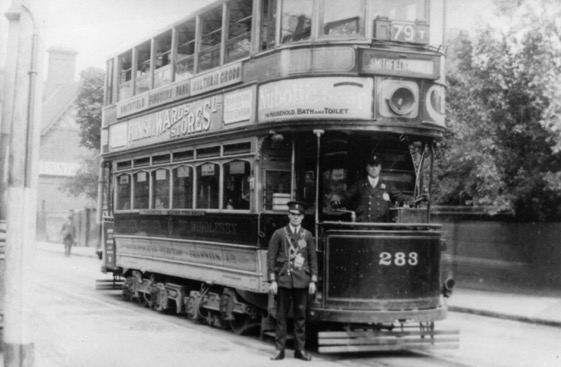
A conductor and a motorman pose with Smithfield Market-bound Tramcar No 283 in 1911. Photo courtesy of the Tramways and Light Railway Society, with thanks to David Voice.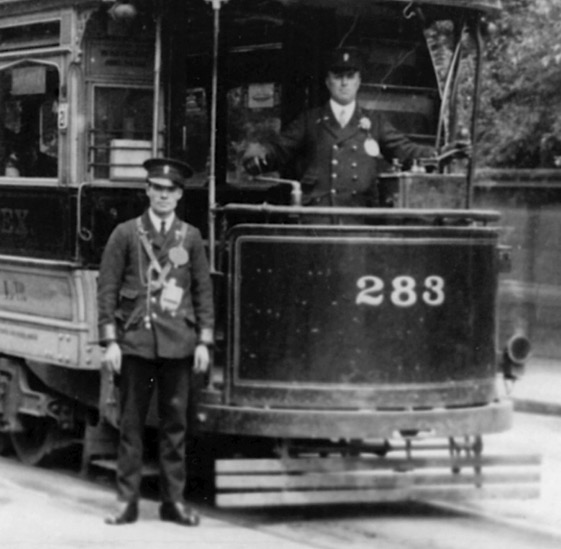
An enlargement of the above photograph showing the conductor and the motorman, both in double-breasted jackets with licences suspended on leather straps.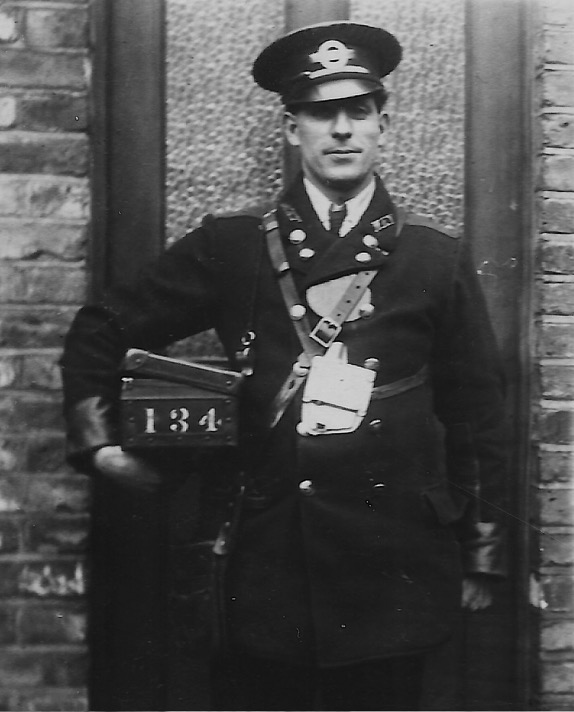
A MET conductor, presumably outside his own house. with the various tools of his trade. The photograph was probably taken in the mid-to-late 1920s or early 1930s. His cap bears the new nickel and blue enamel 'bullseye' cap badge, his collars one-piece 'MET' system initials badges. Photo courtesy of the Dave Jones Collection.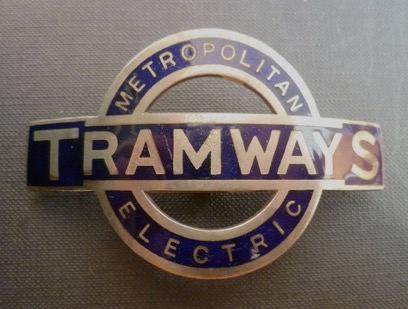
MET cap badge — nickel and blue enamel. This pattern of badge was worn from circa 1920 through to advent of the London Passenger Transport Board in 1933.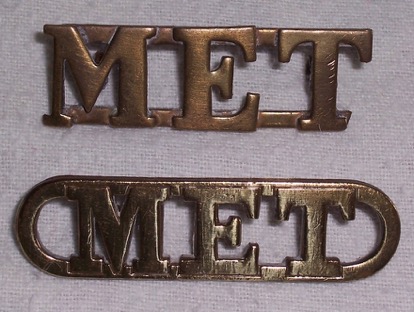
'MET' collar badges — brass (c1920 to 1933). Author's Collection.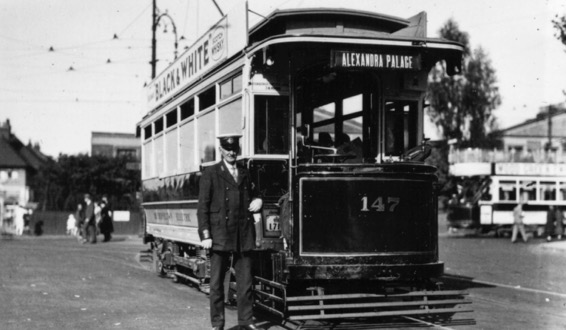
A smart motorman stands with Type E tramcar No 147 bound for Alexandra Palace — photo undated, but probably shortly in the mid-1920s. Photo courtesy of the Tramways and Light Railway Society, with thanks to David Voice.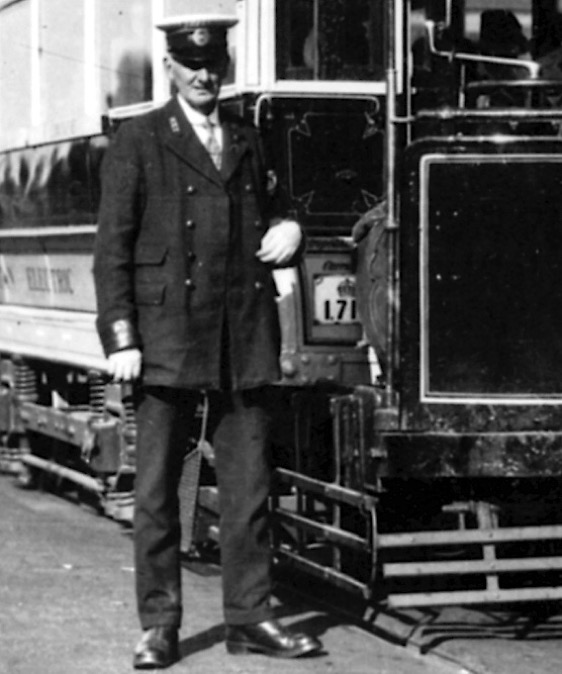
An enlargement of the above photograph showing the motorman. He is wearing the new LSTCo 'bullseye cap badge', along with one-piece, brass 'MET' collar badges.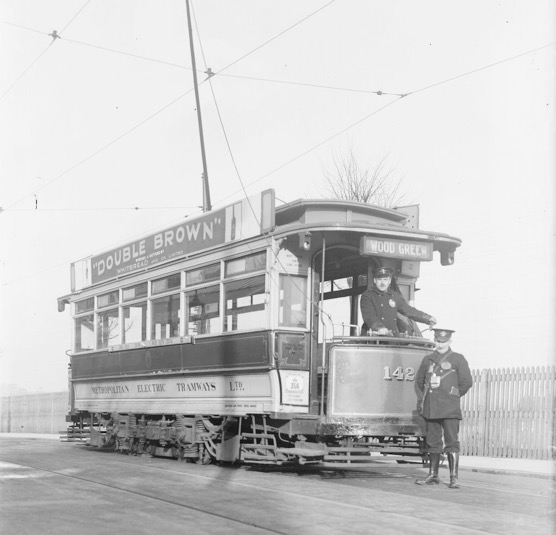
A motorman and a conductor pose with Tramcar 142 at Alexandra Park with a service for Wood Green — photo taken by Dr H Nicol in December 1929. With thanks to the National Tramway Museum. 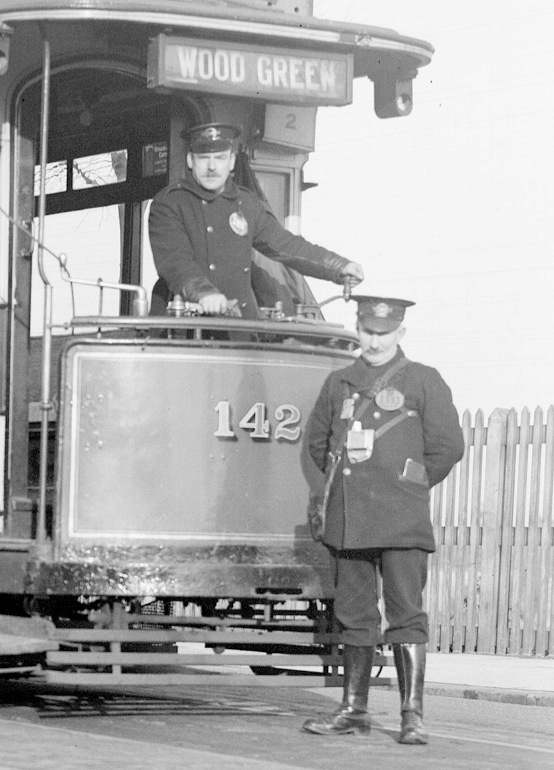
An enlargement of the above photograph showing the motorman and the conductor. Both men are wearing the 'LSTCo' blue enamel cap badges. Photographer, H Nicol. With thanks to the National Tramway Museum. 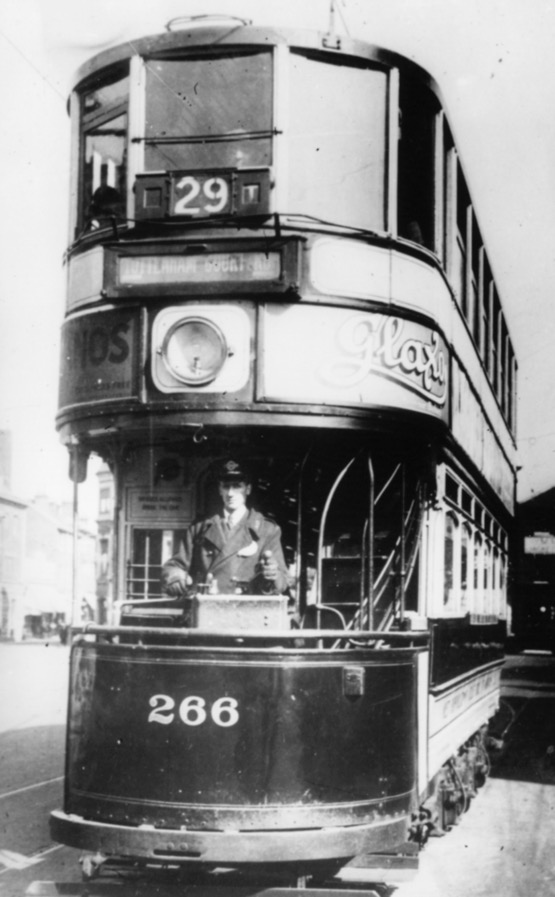
A motorman at the controls of Type H tramcar No 266 on Route 29 — photo undated, but probably taken in the mid-1920s. Photo courtesy of the Tramways and Light Railway Society, with thanks to David Voice.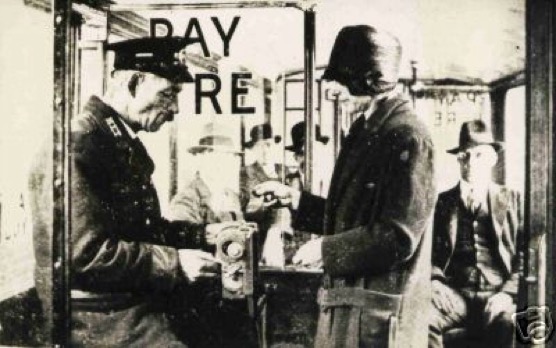
A conductor issuing a ticket on the 'Pay As You Pass' principle, which was trialled aboard prototype Tramcar No 330 in 1929. The 'MET' collar badge is clearly seen. Photo courtesy of the Tramways and Light Railway Society, with thanks to David Voice.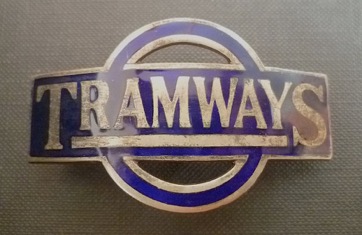
General 'LSTCo' Tramways cap badge — nickel and blue enamel. Worn from c1920 through to advent of the London Passenger Transport Board in 1933. Author's Collection.
General 'LSTCo' Tramways collar badge — brass (c1920 to 1933). Author's Collection.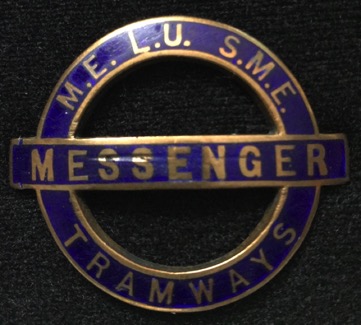
LSTCo 'MESSENGER' cap badge — nickel and blue enamel (c1920 to 1933). Note that in contrast to the Official's cap badge below, each of the constituent tramway initials misses the 'T' off. Photo courtesy of Matt Lodge.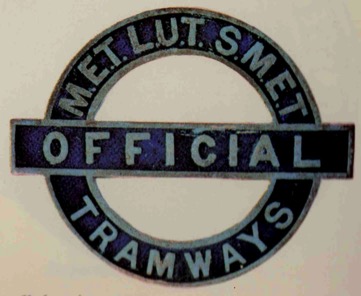
Official's badge — nickel, (with acknowledgement to 'Wheels of London', Times Newspapers Ltd, 1972). Worn from c1920 to 1933).
Senior staff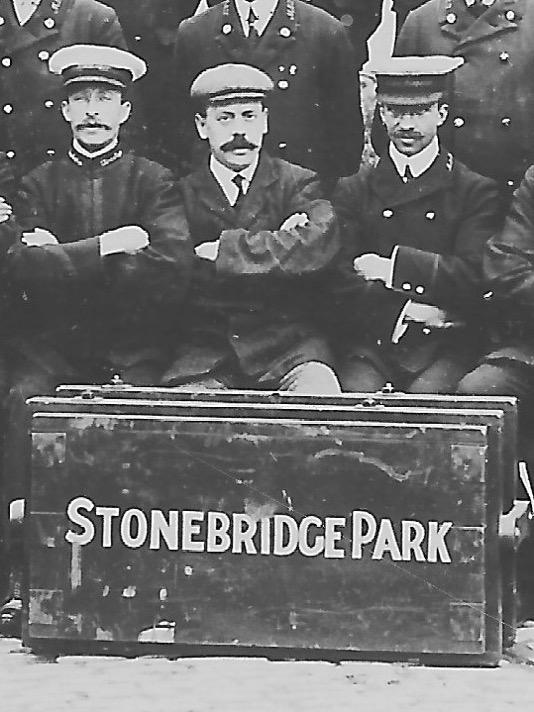
An enlargement of the 1906 Stonebridge Park staff photograph above showing two inspectors, the one on the left having an 'Inspector' grade badge on his cap and collars, the one on the right having a two-line title on his cap, possibly 'Ticket Inspector' or even 'Chief Inspector'. The inspector is wearing a typical tramway inspector's uniform with a tensioned-crown peaked cap. The other man is wearing a very similar jacket to the tramcar crews, but without the leather cuffs and with two buttons on each cuff. Although there is no sign of the standard BETCo cap badge on the caps, this is in all likelihood obscured by the white rain covers.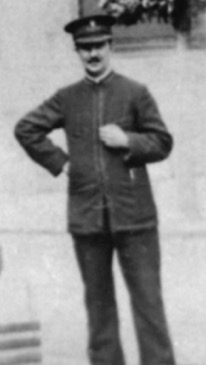
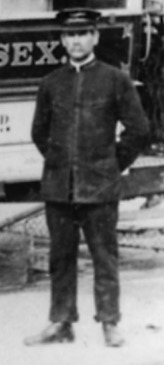
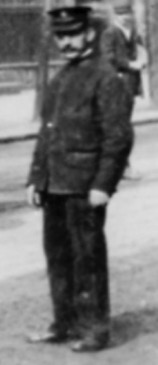
Three views of MET inspectors, all taken prior to the Great War. Photos courtesy of the Tramways and Light Railway Society, with thanks to David Voice.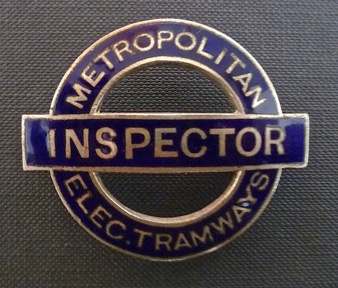
MET inspector's cap badge — nickel and blue enamel — worn from c1920 until the creation of the London Passenger Transport Board in 1933. Author's Collection.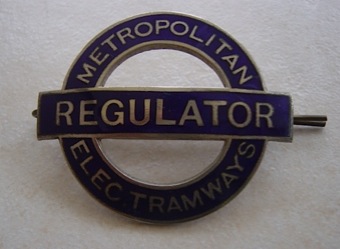
MET regulator's cap badge — nickel and blue enamel — worn from c1920 until the creation of the London Passenger Transport Board in 1933. Photo courtesy of Dave Lewis.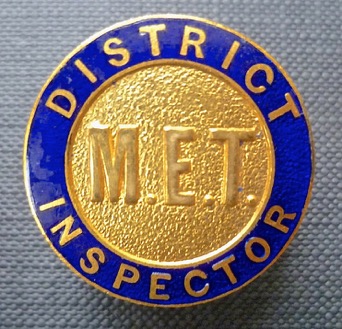
MET district inspector's cap badge — brass and blue enamel (c1920 to 1933). Author's Collection.
Female staff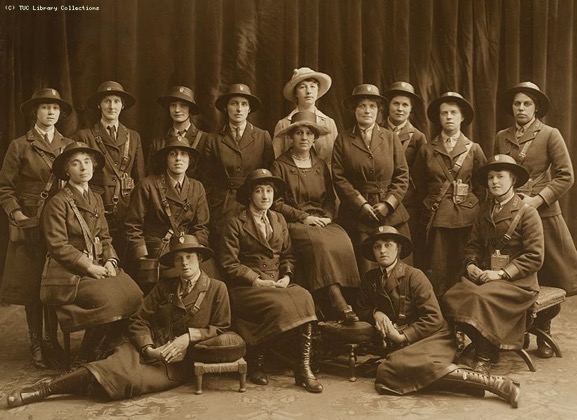
A studio portrait of MET conductresses taken in either 1917 or 1918. All are wearing the BETCo 'Magnet & Wheel' cap badge, strongly suggesting that its replacement, the LTSCo 'bullseye' badge (see above), was not issued until after the war had finished. Image copyright Rita Ferris-Taylor, courtesy of TUC Library Collections.